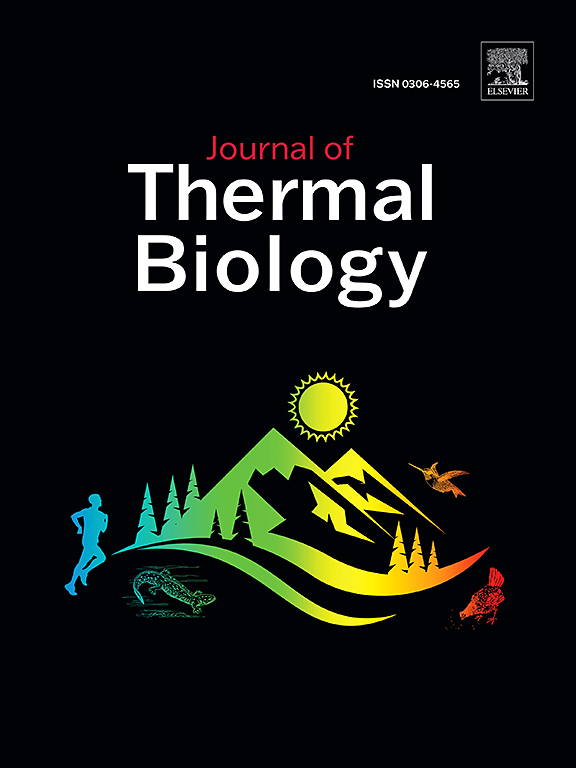探索性评估局部皮肤血管舒张剂对局部加热的反应在年轻和老年女性
IF 2.9
2区 生物学
Q2 BIOLOGY
引用次数: 0
摘要
目的探讨年轻女性和老年女性局部加热时皮肤血管传导率(%CVCmax)的区域差异和潜在的年龄效应。方法10例年轻(21.4±3.4岁)和10例老年(69.8±2.7岁)女性在快速局部皮肤加热的情况下,采用激光多普勒血流法测定胸部、腹部、前臂和大腿的CVCmax %。在基线期间,局部温度设置为34°C,然后增加到39°C,然后每30分钟增加42°C。在基线、初始血管扩张剂峰值以及39°C和42°C加热平台时,评估年龄组之间和年龄组内CVCmax %的差异。结果在年轻女性中,各区域的反应相似,除了腹部的CVCmax %在加热阶段相对于其他区域减少(所有P <;0.040)。相比之下,仅在39°C高原期间,与其他地区相比,老年女性的小牛反应更大(所有P <;0.049)。与年轻女性相比,老年女性在42°C平台期间腹部的%CVCmax更大(P = 0.022)。同样,不同地点的反应也有显著差异(P = 0.035)。在我们的探索性研究中,我们观察到年轻和老年女性的区域差异,以及不同的反应模式和发热阶段。此外,除了年龄较大的女性在42°C峰值时的反应稍大外,未观察到%CVCmax的年龄相关差异。这些发现强调了在评估血管对热的反应时,需要理清性别和年龄的影响,并为微血管功能障碍的性别特异性研究提供重要基础。本文章由计算机程序翻译,如有差异,请以英文原文为准。
An exploratory assessment of regional cutaneous vasodilator responses to local heating in young and older females
Objective
To explore regional differences and potential age effects in cutaneous vascular conductance (%CVCmax) during local heating in young and older females.
Methods
In 10 young (21.4 ± 3.4 years) and 10 older (69.8 ± 2.7 years) females, %CVCmax was assessed using laser-Doppler flowmetry at the chest, abdomen, forearm, and thigh during rapid, local skin heating. Local temperature was set at 34 °C during baseline and increased to 39 °C, then 42 °C in 30 min increments each. Differences in %CVCmax between and within age groups were evaluated at baseline, the initial vasodilator peak, and both the 39 °C and 42 °C heating plateaus.
Results
In young females, responses were similar across regions with the exception that %CVCmax was reduced for the abdomen across heating phases relative to other regions (all P < 0.040). In contrast, calf responses in older females were greater compared to other regions during the 39 °C plateau only (all P < 0.049). %CVCmax was greater at the abdomen during the 42 °C plateau (P = 0.022) for older females compared to young. Similarly, responses pooled across sites were significantly different (P = 0.035).
Conclusion
In our exploratory study we observed regional differences for both young and older females, and the pattern of response and the heating phases where differences occurred varied. Further, no age-related differences in %CVCmax were observed apart from a marginally greater response for older females at peak heating of 42 °C. These findings highlight the need to disentangle the effects of sex and age in evaluating the vascular responses to heat and provide a critical foundation for sex-specific investigations into microvascular dysfunction.
求助全文
通过发布文献求助,成功后即可免费获取论文全文。
去求助
来源期刊

Journal of thermal biology
生物-动物学
CiteScore
5.30
自引率
7.40%
发文量
196
审稿时长
14.5 weeks
期刊介绍:
The Journal of Thermal Biology publishes articles that advance our knowledge on the ways and mechanisms through which temperature affects man and animals. This includes studies of their responses to these effects and on the ecological consequences. Directly relevant to this theme are:
• The mechanisms of thermal limitation, heat and cold injury, and the resistance of organisms to extremes of temperature
• The mechanisms involved in acclimation, acclimatization and evolutionary adaptation to temperature
• Mechanisms underlying the patterns of hibernation, torpor, dormancy, aestivation and diapause
• Effects of temperature on reproduction and development, growth, ageing and life-span
• Studies on modelling heat transfer between organisms and their environment
• The contributions of temperature to effects of climate change on animal species and man
• Studies of conservation biology and physiology related to temperature
• Behavioural and physiological regulation of body temperature including its pathophysiology and fever
• Medical applications of hypo- and hyperthermia
Article types:
• Original articles
• Review articles
 求助内容:
求助内容: 应助结果提醒方式:
应助结果提醒方式:


